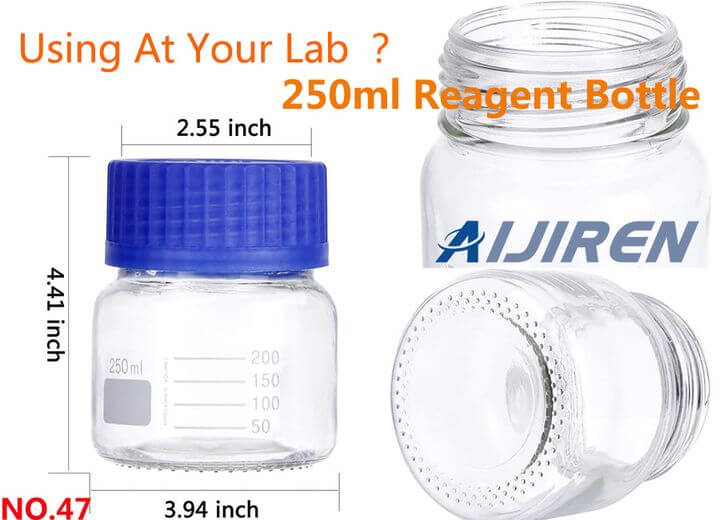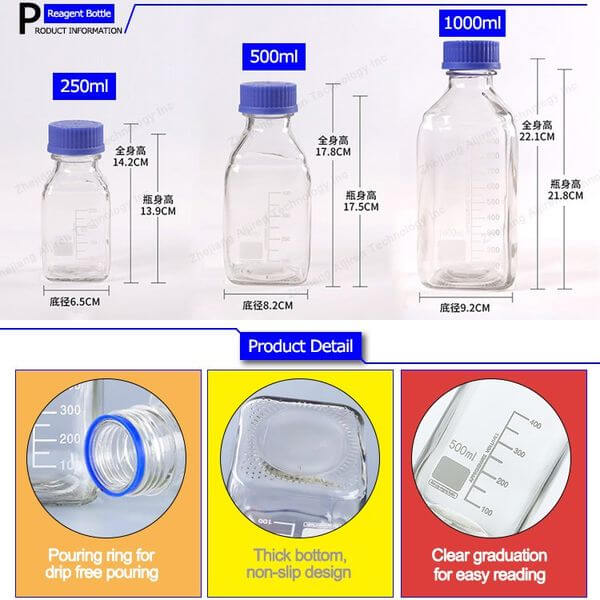What are the Applications of Reagent Bottles?
The reagent bottles, also known as media bottles, are used to store chemicals in liquid or powder form. Reagent bottles are generally made up of glass or plastic. The first reagent bottles were manufactured by Duran in 1972. The reagent bottles were primarily designed to store reagents. But various other chemicals can be stored in reagent bottles with the development of improved designs.

What functions do reagent bottles need?
Chemical reagents play an important role in the day-to-day operations of factories, schools, hospitals, and research institutes, and proper reagent bottle selection is required for reagent storage. There are many types of chemical reagents with different properties, but what kind of function does a reagent bottle need?
The categories of chemical reagents are basically categorized by application and field, and many new categories were added overseas in the 1980s. The German company Imak is divided into 20 categories and 88 subcategories. The American Baker Company has 75 major categories and 124 subcategories. With the development of science and technology, the types of chemical reagents are increasing, the tendency of classification is becoming finer, and the types are serialized and matched.
As a basic container for storing various chemical reagents, reagent bottles must first be corrosion-resistant. Chemical reagents include many acid and alkaline reagents. The material of the bottle should have excellent corrosion resistance to solvents such as acids and alkalis. Make sure that the chemical reagents are well stored.
The second is air tightness. Some chemical reagents are prone to oxidation or volatilization, and a tight seal prevents the ingress of outside air and prevents the reagents from volatilizing and oxidative deterioration after contact with air.
In addition, some specialized chemical reagents, such as silver nitrate, iodine, and other photosensitive reagents, have special requirements for the color of reagent bottles. It should be placed in a brown bottle to prevent decomposition after exposure to light. Reagent bottles with rye and water glass stoppers cannot be used for storage. Together, these various bottles form a storage container for chemical reagents to meet storage requirements for reagents with different properties.

What are the applications of reagent bottles?
A plastic reagent bottle is a container used to hold chemical reagents. Reagent bottle is mainly processed from polyethylene or polypropylene raw materials. A reagent bottle can resist the corrosion of most acid and alkali solvents, which is a good packaging container. Holding chemical reagents is one of the basic uses of plastic reagent bottles. According to the characteristics of the reagents, reagent bottles are divided into wide-mouth reagent bottles, narrow-mouth reagent bottles, brown reagent bottles, and glass reagent bottles, which can hold solid or liquid reagents.
However, plastic reagent bottles are not suitable for strong oxidizing, strong acid-base, and strong reducing liquid. In-vitro diagnostics refers to products and services that obtain clinical diagnostic information by testing human samples, such as blood, body fluids, or tissues, outside the human body to determine diseases or body functions. Reagent bottles are mainly used for the packaging of test reagents in the field of in vitro diagnostics.
Foliar fertilizer generally needs to be diluted before use. The requirements for packaging are mainly reflected in the material and sealing. The reagent bottle is made of polypropylene or polyethylene, which is resistant to most acid and alkali corrosion. Reagent bottles have the advantages of light texture, convenient transportation, and low price, which can meet the storage requirements of flower foliar fertilizer.
Conclusion
Learn more about reagent bottles can know the functions of reagent bottles and their features of reagent bottles. Zhejiang Aijiren Technology, Inc. is equipped with many professors in reagent bottles or any other chromatography consumables. We are glad to hear from you about any questions. You can contact us via e-mail or phone call. In addition, we also provide Lab Reagents products.
Back to List
-
 下午4:09Weighing the Pros and Cons of PTFE/Silicone Septa
下午4:09Weighing the Pros and Cons of PTFE/Silicone Septa -
 下午4:05Decoding Vial Discard Guidelines: Ensuring Precision in Chromatography
下午4:05Decoding Vial Discard Guidelines: Ensuring Precision in Chromatography -
 下午5:01Navigating Micro Inserts for HPLC Vials: A Comprehensive Guide
下午5:01Navigating Micro Inserts for HPLC Vials: A Comprehensive Guide -
.jpg) 下午2:02Common faults and solutions of automatic samplers(2)
下午2:02Common faults and solutions of automatic samplers(2) -
 下午5:08Ensuring Sample Integrity: Navigating EPA Storage Vials Stability Guidelines
下午5:08Ensuring Sample Integrity: Navigating EPA Storage Vials Stability Guidelines

